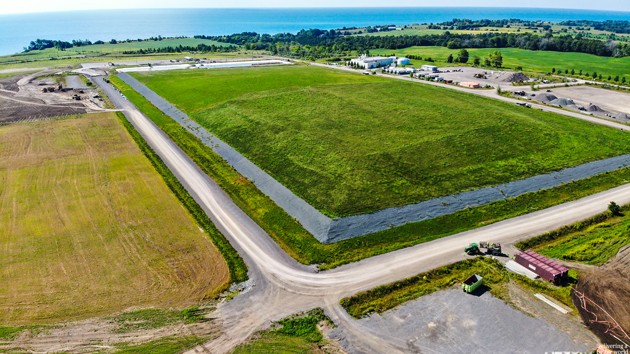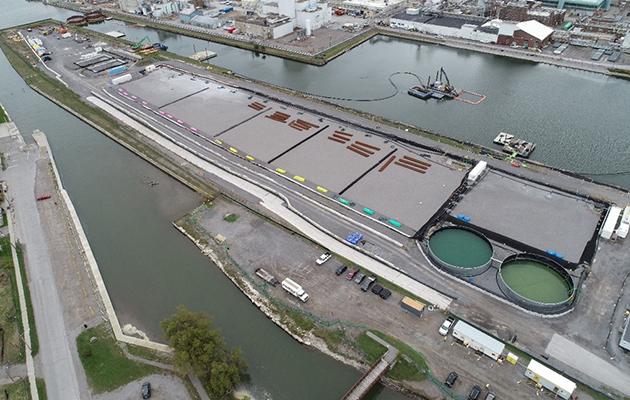Port Hope Area Initiative: Protecting Canada’s Environment for Future Generations
Port Hope & Clarington, Ontario
Project Duration: 2012 – 2015
Project Budget: $1.28 billion
Client: Public Services and Procurement Canada
Services: Project Management, Advisory

Port Granby Long-Term Waste Management Facility
The Port Hope Area Initiative (PHAI) is one of the largest and most complex environmental cleanup projects ever undertaken in Canada.
Launched by the Government of Canada in 2012, this multi-site, multi-year initiative aimed to locate and identify, then clean up, transport, and safely manage approximately 2.5 million cubic metres of historic low-level radioactive waste. The waste was spread across hundreds of residential, commercial, and public properties in several municipalities, including Port Hope and Clarington.
A byproduct of refining practices by Eldorado Nuclear Limited and its predecessors between 1933 and 1988, the waste poses long-term risks to land use, community health, and the surrounding environment.
The initiative was divided into two projects—Port Hope and Port Granby—each requiring a long-term waste management facility, in the form of an engineered above-ground mound, and a wastewater treatment plant to effectively contain, process, and treat the waste.
This community-recommended solution will protect the health and safety of residents, safeguard the Great Lakes Basin ecosystem, and ensure the continued use of public lands for generations to come.
Scope
The projects required a tailored project management approach that accounted for the needs of multiple stakeholders, the proximity to homes and businesses, and strict requirements for radiation protection and environmental monitoring.
The goals of the Port Hope Area Initiative are to:
- Identify and locate varying types of low-level radioactive waste in the surrounding municipalities
- Clean up, transport, and manage low-level radioactive waste from public and private properties
- Effectively communicate to residents the risks, policies, and procedures in place to protect the public
- Remediate non-radioactive industrial waste from various sites
- Construct two long-term waste management facilities to safely manage the waste over the long term
- Build two wastewater treatment plants to treat surface water, groundwater, and contaminated water from within the engineered above-ground mounds
Executing on these goals required careful environmental, health, and logistical planning across hundreds of impacted sites—including roadways, residential properties, commercial sites, and public facilities like schools and parks. Locating and identifying the different types of low-level radioactive waste was also a key challenge that shaped the scope of the cleanup activities.
Given the impact on both public and private properties, communication with political leaders, municipal representatives, and residents was critical throughout, and helped ensure the project progressed with public support.
Approach
Between 2012 and 2015, Tiree supported Public Services and Procurement Canada (PSPC)—working in partnership with the surrounding municipalities—with Advisory and Project Management services.
Given the project’s sensitive nature, the high level of public visibility, and technical complexity, Tiree focused its efforts on stakeholder coordination, policy alignment, and risk mitigation. This helped ensure that early planning efforts aligned with federal policy requirements and public expectations.
Our approach to minimizing disruption and building public trust included:
- Coordinating with municipal and public stakeholders
- Preparing materials for and presenting at public information meetings
- Developing policy, program management strategies, and internal controls for compliance
- Creating business cases for Treasury Board submissions
- Assessing program risks across delivery models and planning contingencies
- Conducting cost-benefit assessments and risk analyses to inform investment decisions
- Managing early works and supporting infrastructure planning
- Procuring design and construction management services, including scope definition
- Identifying the means and methods for transporting low-level radioactive waste
- Supporting operating procedures, scheduling, and program monitoring
- Preparing for audits, evaluations, and performance reporting
Outcomes
Although the Port Hope Area Initiative is still underway, significant milestones have already been achieved.
The construction of the long-term waste management facility and wastewater treatment plant in Port Granby is complete. 750,000 m3 of waste has been successfully relocated to an engineered above-ground mound designed for safe, long-term waste containment. These efforts are enabling safer land use, rebuilding community trust, and improving environmental quality for residents of Port Hope, Clarington, and the surrounding municipalities.
Tiree’s contributions helped PSPC implement effective governance and stakeholder communication, ensuring the project moved forward responsibly and with public buy-in.

Port Hope Harbour
